STAY-GREEN Accelerates Chlorophyll Degradation in Magnolia sinostellata under the Condition of Light Deficiency
Abstract
1. Introduction
2. Results
2.1. The Light Intensity Received by M. sinostellata Varys Greatly among Different Forest Communities
2.2. Light Deficiency Accelerated Leaves Senescence in M. sinostellata
2.3. Expression Patterns of Genes Involved in Chlorophyll Biosynthesis and Degradation Pathway in M. sinostellata under Light Deficiency Conditions
2.4. Identification and Characterization of MsSGR
2.5. MsSGR Induced Chlorophyll Degradation in Arabidopsis and Tobacco
2.6. Light Deficiency Promotes MsSGR Promoter Activity
2.7. Potential Interacting Proteins of MsSGR by Y2H Analysis
3. Discussion
4. Material and Methods
4.1. Light Intensity Measurement in Habitats of M. sinostellata
4.2. Plants Materials and Light Deficiency Treatments
4.3. Determination of Chlorophyll Content
4.4. Transcriptome Analysis of Chlorophyll Metabolism Pathway Genes
4.5. RNA Extraction, cDNA Synthesis, and DNA Preparation
4.6. Expression Analysis of Chlorophyll Biosynthesis and Degradation Gene in Light Deficiency Stress and MsSGR in Different Tissues
4.7. Cloning of the MsSGR Gene and Bioinformatics Analysis
4.8. MsSGR Subcellular Localization and Overexpression in Arabidopsis and Tobacco
4.9. MsSGR Promoters Clone and Activity Analysis
4.10. Construction of Yeast Two-Hybrid (Y2H) pGADT7 Library
4.11. Yeast Two-Hybrid (Y2H) Screen of MsSGR Protein
5. Conclusions
Supplementary Materials
Author Contributions
Funding
Institutional Review Board Statement
Informed Consent Statement
Data Availability Statement
Conflicts of Interest
References
- Shen, Y.; Meng, D.; McGrouther, K.; Zhang, J.; Cheng, L. Efficient isolation of Magnolia protoplasts and the application to subcellular localization of MdeHSF1. Plant Methods 2017, 13, 44. [Google Scholar] [CrossRef] [PubMed]
- Setsuko, S.; Ishida, K.; Ueno, S.; Tsumura, Y.; Tomaru, N. Population differentiation and gene flow within a metapopulation of a threatened tree, Magnolia stellata (Magnoliaceae). Am. J. Bot. 2007, 94, 128–136. [Google Scholar] [CrossRef] [PubMed]
- Yang, Y.; Jia, Z.; Chen, F.; Sang, Z.; Ma, L. Optimal Light Regime for the Rare Species Magnolia wufengensis in Northern China. Plant Sci. J. 2015, 33, 377–387. [Google Scholar]
- Tan, M.; Yang, Z.; Yang, X.; Cheng, X.; Li, G.; Ma, W. Study on Seed Germination and Seedling Growth of Houpoöa officinalis in Different Habitats. J. Ecol. Rural. Environ. 2018, 34, 910–916. [Google Scholar]
- Yang, Q.; Xiao, Z.; Hu, X.; Ouyang, M.; Chen, X.; Lin, G.; Xu, J.; Yang, G. Endangered mechanisms of Sinomanglietia glauca: Exploring and prospect. Guihaia 2017, 37, 653–660. [Google Scholar]
- Yu, Z.; Chen, X.; Lu, L.; Liu, X.; Yin, H.; Shen, Y. Distribution and Community Structure of Magnolia sinostellata. J. Zhejiang For. Sci. Technol. 2015, 35, 47–52. [Google Scholar]
- Lu, D.; Liu, B.; Ren, M.; Wu, C.; Ma, J.; Shen, Y. Light Deficiency Inhibits Growth by Affecting Photosynthesis Efficiency as well as JA and Ethylene Signaling in Endangered Plant Magnolia sinostellata. Plants 2021, 10, 2261. [Google Scholar] [CrossRef]
- Gao, S.; Liu, X.; Liu, Y.; Cao, B.; Chen, Z.; Xu, K. The Spectral Irradiance, Growth, Photosynthetic Characteristics, Antioxidant System, and Nutritional Status of Green Onion (Allium fistulosum L.) Grown under Different Photo-Selective Nets. Front. Plant Sci. 2021, 12, 650471. [Google Scholar] [CrossRef]
- Kim, B.; Jeong, Y.J.; Corvalan, C.; Fujioka, S.; Cho, S.; Park, T.; Choe, S. Darkness and gulliver2/phyB mutation decrease the abundance of phosphorylated BZR1 to activate brassinosteroid signaling in Arabidopsis. Plant J. 2014, 77, 737–747. [Google Scholar] [CrossRef]
- Katahata, S.; Naramoto, M.; Kakubari, Y.; Mukai, Y. Photosynthetic capacity and nitrogen partitioning in foliage of the evergreen shrub Daphniphyllum humile along a natural light gradient. Tree Physiol 2007, 27, 199–208. [Google Scholar] [CrossRef]
- Casal, J.J. Photoreceptor signaling networks in plant responses to shade. Annu. Rev. Plant Biol. 2013, 64, 403–427. [Google Scholar] [CrossRef] [PubMed]
- Martínez-García, J.F.; Galstyan, A.; Salla-Martret, M.; Cifuentes-Esquivel, N.; Gallemí, M.; Bou-Torrent, J. Regulatory Components of Shade Avoidance Syndrome. Adv. Bot. Res. 2010, 53, 65–116. [Google Scholar]
- Domingos, S.; Scafidi, P.; Cardoso, V.; Leitao, A.E.; Di Lorenzo, R.; Oliveira, C.M.; Goulao, L.F. Flower abscission in Vitis vinifera L. triggered by gibberellic acid and shade discloses differences in the underlying metabolic pathways. Front. Plant Sci. 2015, 6, 457. [Google Scholar] [CrossRef] [PubMed]
- Zhao, D.; Hao, Z.; Tao, J. Effects of shade on plant growth and flower quality in the herbaceous peony (Paeonia lactiflora Pall.). Plant Physiol. Biochem. 2012, 61, 187–196. [Google Scholar] [CrossRef] [PubMed]
- Liu, L.; Lin, N.; Liu, X.; Yang, S.; Wang, W.; Wan, X. From Chloroplast Biogenesis to Chlorophyll Accumulation: The Interplay of Light and Hormones on Gene Expression in Camellia sinensis cv. Shuchazao Leaves. Front. Plant Sci. 2020, 11, 256. [Google Scholar] [CrossRef]
- Hashemi-Dezfouli, A.; Herbert, S.J. Intensifying Plant Density Response of Corn with Artificial Shade. Agron. J. 1992, 84, 547–551. [Google Scholar] [CrossRef]
- Tanaka, R.; Tanaka, A. Tetrapyrrole biosynthesis in higher plants. Annu. Rev. Plant Biol. 2007, 58, 321–346. [Google Scholar] [CrossRef]
- Bollivar, D.W. Recent advances in chlorophyll biosynthesis. Photosynth. Res. 2006, 90, 173–194. [Google Scholar] [CrossRef]
- Meguro, M.; Ito, H.; Takabayashi, A.; Tanaka, R.; Tanaka, A. Identification of the 7-hydroxymethyl chlorophyll a reductase of the chlorophyll cycle in Arabidopsis. Plant Cell 2011, 23, 3442–3453. [Google Scholar] [CrossRef]
- Nagata, N.; Tanaka, R.; Satoh, S.; Tanaka, A. Identification of a vinyl reductase gene for chlorophyll synthesis in Arabidopsis thaliana and implications for the evolution of Prochlorococcus species. Plant Cell 2005, 17, 233–240. [Google Scholar] [CrossRef]
- Beale, S.I. Green genes gleaned. Trends Plant Sci. 2005, 10, 309–312. [Google Scholar] [CrossRef] [PubMed]
- Kumar, A.M.; Soll, D. Antisense HEMA1 RNA expression inhibits heme and chlorophyll biosynthesis in Arabidopsis. Plant Physiol. 2000, 122, 49–56. [Google Scholar] [CrossRef] [PubMed]
- Zhang, H.; Li, J.; Yoo, J.H.; Yoo, S.C.; Cho, S.H.; Koh, H.J.; Seo, H.S.; Paek, N.C. Rice Chlorina-1 and Chlorina-9 encode ChlD and ChlI subunits of Mg-chelatase, a key enzyme for chlorophyll synthesis and chloroplast development. Plant Mol. Biol. 2006, 62, 325–337. [Google Scholar] [CrossRef] [PubMed]
- Zhou, D.; Li, T.; Yang, Y.; Qu, Z.; Ouyang, L.; Jiang, Z.; Lin, X.; Zhu, C.; Peng, L.; Fu, J.; et al. OsPLS4 Is Involved in Cuticular Wax Biosynthesis and Affects Leaf Senescence in Rice. Front. Plant Sci. 2020, 11, 782. [Google Scholar] [CrossRef]
- Pruzinska, A.; Tanner, G.; Aubry, S.; Anders, I.; Moser, S.; Muller, T.; Ongania, K.H.; Krautler, B.; Youn, J.Y.; Liljegren, S.J.; et al. Chlorophyll breakdown in senescent Arabidopsis leaves. Characterization of chlorophyll catabolites and of chlorophyll catabolic enzymes involved in the degreening reaction. Plant Physiol. 2005, 139, 52–63. [Google Scholar] [CrossRef]
- Kusaba, M.; Ito, H.; Morita, R.; Iida, S.; Sato, Y.; Fujimoto, M.; Kawasaki, S.; Tanaka, R.; Hirochika, H.; Nishimura, M.; et al. Rice Non-Yellow Coloring1 is involved in light-harvesting complex II and grana degradation during leaf senescence. Plant Cell 2007, 19, 1362–1375. [Google Scholar] [CrossRef]
- Hortensteiner, S.; Krautler, B. Chlorophyll breakdown in higher plants. Biochim. Biophys. Acta 2011, 1807, 977–988. [Google Scholar] [CrossRef]
- Sakuraba, Y.; Schelbert, S.; Park, S.Y.; Han, S.H.; Lee, B.D.; Andres, C.B.; Kessler, F.; Hortensteiner, S.; Paek, N.C. Stay-Green and chlorophyll catabolic enzymes interact at light-harvesting complex II for chlorophyll detoxification during leaf senescence in Arabidopsis. Plant Cell 2012, 24, 507–518. [Google Scholar] [CrossRef]
- Qiu, K.; Li, Z.; Yang, Z.; Chen, J.; Wu, S.; Zhu, X.; Gao, S.; Gao, J.; Ren, G.; Kuai, B.; et al. EIN3 and ORE1 Accelerate Degreening during Ethylene-Mediated Leaf Senescence by Directly Activating Chlorophyll Catabolic Genes in Arabidopsis. PLoS Genet. 2015, 11, e1005399. [Google Scholar] [CrossRef]
- Delmas, F.; Sankaranarayanan, S.; Deb, S.; Widdup, E.; Bournonville, C.; Bollier, N.; Northey, J.G.; McCourt, P.; Samuel, M.A. ABI3 controls embryo degreening through Mendel’s I locus. Proc. Natl. Acad. Sci. USA 2013, 110, E3888–E3894. [Google Scholar] [CrossRef]
- Zhu, X.; Chen, J.; Xie, Z.; Gao, J.; Ren, G.; Gao, S.; Zhou, X.; Kuai, B. Jasmonic acid promotes degreening via MYC2/3/4- and ANAC019/055/072-mediated regulation of major chlorophyll catabolic genes. Plant J. 2015, 84, 597–610. [Google Scholar] [CrossRef] [PubMed]
- Sakuraba, Y.; Jeong, J.; Kang, M.Y.; Kim, J.; Paek, N.C.; Choi, G. Phytochrome-interacting transcription factors PIF4 and PIF5 induce leaf senescence in Arabidopsis. Nat. Commun. 2014, 5, 4636. [Google Scholar] [CrossRef] [PubMed]
- Zhang, Y.; Liu, Z.; Chen, Y.; He, J.X.; Bi, Y. PHYTOCHROME-INTERACTING FACTOR 5 (PIF5) positively regulates dark-induced senescence and chlorophyll degradation in Arabidopsis. Plant Sci. 2015, 237, 57–68. [Google Scholar] [CrossRef] [PubMed]
- Magnolia sinostellata. The IUCN Red List of Threatened Species 2015. Available online: https://doi.org/10.2305/IUCN.UK.2015-2.RLTS.T69306476A69306540.en (accessed on 15 February 2023).
- Yu, Q.; Shen, Y.; Wang, Q.; Wang, X.; Fan, L.; Wang, Y.; Zhang, S.; Liu, Z.; Zhang, M. Light deficiency and waterlogging affect chlorophyll metabolism and photosynthesis in Magnolia sinostellata. Trees 2018, 33, 11–22. [Google Scholar] [CrossRef]
- Chen, T.; Zhang, H.; Zeng, R.; Wang, X.; Huang, L.; Wang, L.; Wang, X.; Zhang, L. Shade Effects on Peanut Yield Associate with Physiological and Expressional Regulation on Photosynthesis and Sucrose Metabolism. Int. J. Mol. Sci. 2020, 21, 5284. [Google Scholar] [CrossRef]
- Semchenko, M.; Lepik, M.; Götzenberger, L.; Zobel, K. Positive effect of shade on plant growth: Amelioration of stress or active regulation of growth rate? J. Ecol. 2012, 100, 459–466. [Google Scholar] [CrossRef]
- Wang, X.; Gao, X.; Liu, Y.; Fan, S.; Ma, Q. Progress of Research on the Regulatory Pathway of the Plant Shade-Avoidance Syndrome. Front. Plant Sci. 2020, 11, 439. [Google Scholar] [CrossRef]
- Sun, W.; Han, H.; Deng, L.; Sun, C.; Xu, Y.; Lin, L.; Ren, P.; Zhao, J.; Zhai, Q.; Li, C. Mediator Subunit MED25 Physically Interacts with phytochrome interacting factor4 to Regulate Shade-Induced Hypocotyl Elongation in Tomato. Plant Physiol. 2020, 184, 1549–1562. [Google Scholar] [CrossRef]
- García-Sánchez, F.; Simón, I.; Lidón, V.; Manera, F.J.; Simón-Grao, S.; Pérez-Pérez, J.G.; Gimeno, V. Shade screen increases the vegetative growth but not the production in ‘Fino 49’ lemon trees grafted on Citrus macrophylla and Citrus aurantium L. Sci. Hortic. 2015, 194, 175–180. [Google Scholar] [CrossRef]
- Lugassi-Ben-Hamo, M.; Kitron, M.; Bustan, A.; Zaccai, M. Effect of shade regime on flower development, yield and quality in lisianthus. Sci. Hortic. 2010, 124, 248–253. [Google Scholar] [CrossRef]
- Lee, S.; Kim, M.H.; Lee, J.H.; Jeon, J.; Kwak, J.M.; Kim, Y.J. Glycosyltransferase-Like RSE1 Negatively Regulates Leaf Senescence through Salicylic Acid Signaling in Arabidopsis. Front. Plant Sci. 2020, 11, 551. [Google Scholar] [CrossRef] [PubMed]
- Jin, D.; Wang, X.; Xu, Y.; Gui, H.; Zhang, H.; Dong, Q.; Sikder, R.K.; Yang, G.; Song, M. Chemical Defoliant Promotes Leaf Abscission by Altering ROS Metabolism and Photosynthetic Efficiency in Gossypium hirsutum. Int. J. Mol. Sci. 2020, 21, 2738. [Google Scholar] [CrossRef] [PubMed]
- Kim, T.; Kang, K.; Kim, S.H.; An, G.; Paek, N.C. OsWRKY5 Promotes Rice Leaf Senescence via Senescence-Associated NAC and Abscisic Acid Biosynthesis Pathway. Int. J. Mol. Sci. 2019, 20, 4437. [Google Scholar] [CrossRef] [PubMed]
- Song, Y.; Yang, C.; Gao, S.; Zhang, W.; Li, L.; Kuai, B. Age-triggered and dark-induced leaf senescence require the bHLH transcription factors PIF3, 4, and 5. Mol. Plant. 2014, 7, 1776–1787. [Google Scholar] [CrossRef] [PubMed]
- Wang, R.; Yang, F.; Zhang, X.Q.; Wu, D.; Tan, C.; Westcott, S.; Broughton, S.; Li, C.; Zhang, W.; Xu, Y. Characterization of a Thermo-Inducible Chlorophyll-Deficient Mutant in Barley. Front. Plant Sci. 2017, 8, 1936. [Google Scholar] [CrossRef] [PubMed]
- Shimoda, Y.; Ito, H.; Tanaka, A. Arabidopsis Stay-Green, Mendel’s Green Cotyledon Gene, Encodes Magnesium-Dechelatase. Plant Cell 2016, 28, 2147–2160. [Google Scholar] [CrossRef]
- Chen, X.; Li, J.; Yu, Y.; Kou, X.; Periakaruppan, R.; Chen, X.; Li, X. Stay-Green and light-harvesting complex II chlorophyll a/b binding protein are involved in albinism of a novel albino tea germplasm ‘Huabai 1’. Sci. Hortic. 2022, 293. [Google Scholar] [CrossRef]
- Ren, G.; An, K.; Liao, Y.; Zhou, X.; Cao, Y.; Zhao, H.; Ge, X.; Kuai, B. Identification of a novel chloroplast protein AtNYE1 regulating chlorophyll degradation during leaf senescence in Arabidopsis. Plant Physiol 2007, 144, 1429–1441. [Google Scholar] [CrossRef]
- Wang, N.; Zhang, C.; Bian, S.; Chang, P.; Xuan, L.; Fan, L.; Yu, Q.; Liu, Z.; Gu, C.; Zhang, S.; et al. Flavonoid Components of Different Color Magnolia Flowers and Their Relationship to Cultivar Selections. HortScience 2019, 54, 404–408. [Google Scholar] [CrossRef]
- Gao, S.; Gao, J.; Zhu, X.; Song, Y.; Li, Z.; Ren, G.; Zhou, X.; Kuai, B. ABF2, ABF3, and ABF4 Promote ABA-Mediated Chlorophyll Degradation and Leaf Senescence by Transcriptional Activation of Chlorophyll Catabolic Genes and Senescence-Associated Genes in Arabidopsis. Mol. Plant 2016, 9, 1272–1285. [Google Scholar] [CrossRef]
- Sato, Y.; Morita, R.; Nishimura, M.; Yamaguchi, H.; Kusaba, M. Mendel’s green cotyledon gene encodes a positive regulator of the chlorophyll-degrading pathway. Proc. Natl. Acad. Sci. USA 2007, 104, 14169–14174. [Google Scholar] [CrossRef] [PubMed]
- Aubry, S.; Mani, J.; Hortensteiner, S. Stay-green protein, defective in Mendel’s green cotyledon mutant, acts independent and upstream of pheophorbide a oxygenase in the chlorophyll catabolic pathway. Plant Mol. Biol. 2008, 67, 243–256. [Google Scholar] [CrossRef] [PubMed]
- Hortensteiner, S. Stay-green regulates chlorophyll and chlorophyll-binding protein degradation during senescence. Trends Plant Sci. 2009, 14, 155–162. [Google Scholar] [CrossRef] [PubMed]
- Luo, Z.; Zhang, J.; Li, J.; Yang, C.; Wang, T.; Ouyang, B.; Li, H.; Giovannoni, J.; Ye, Z. A Stay-Green protein SlSGR1 regulates lycopene and beta-carotene accumulation by interacting directly with SlPSY1 during ripening processes in tomato. New Phytol. 2013, 198, 442–452. [Google Scholar] [CrossRef] [PubMed]
- Bibhuti Bhusan Mishra, B.x. Polyphonel Oxidases: Biochemical and Molecular Characterization, Distribution, Role and its Control. Enzym. Eng. 2016, 05, 141–149. [Google Scholar] [CrossRef]
- Fu, S.; Shao, J.; Zhou, C.; Hartung, J.S. Co-infection of Sweet Orange with Severe and Mild Strains of Citrus tristeza virus Is Overwhelmingly Dominated by the Severe Strain on Both the Transcriptional and Biological Levels. Front. Plant Sci. 2017, 8, 1419. [Google Scholar] [CrossRef]
- Chen, J. Conversion relationship between lx and umol·m−2 s−1 of practical light source. Acta Agric. Univ. Henanensis 1998, 32, 200–202. [Google Scholar]
- Wellburn, A.R.; Lichtenthaler, H. Formulae and Program to Determine Total Carotenoids and Chlorophylls A and B of Leaf Extracts in Different Solvents. In Advances in Photosynthesis Research, Proceedings of the VIth International Congress on Photosynthesis, Brussels, Belgium, 1–6 August 1983; Volume 2; Sybesma, C., Ed.; Springer: Dordrecht, The Netherlands, 1984; pp. 9–12. [Google Scholar]
- Livak, K.J.; Schmittgen, T.D. Analysis of relative gene expression data using real-time quantitative PCR and the 2(-Delta Delta C(T)) Method. Methods 2001, 25, 402–408. [Google Scholar] [CrossRef]
- Dong, S.; Liu, M.; Liu, Y.; Chen, F.; Yang, T.; Chen, L.; Zhang, X.; Guo, X.; Fang, D.; Li, L.; et al. The genome of Magnolia biondii Pamp. provides insights into the evolution of Magnoliales and biosynthesis of terpenoids. Hortic. Res. 2021, 8, 38. [Google Scholar] [CrossRef]
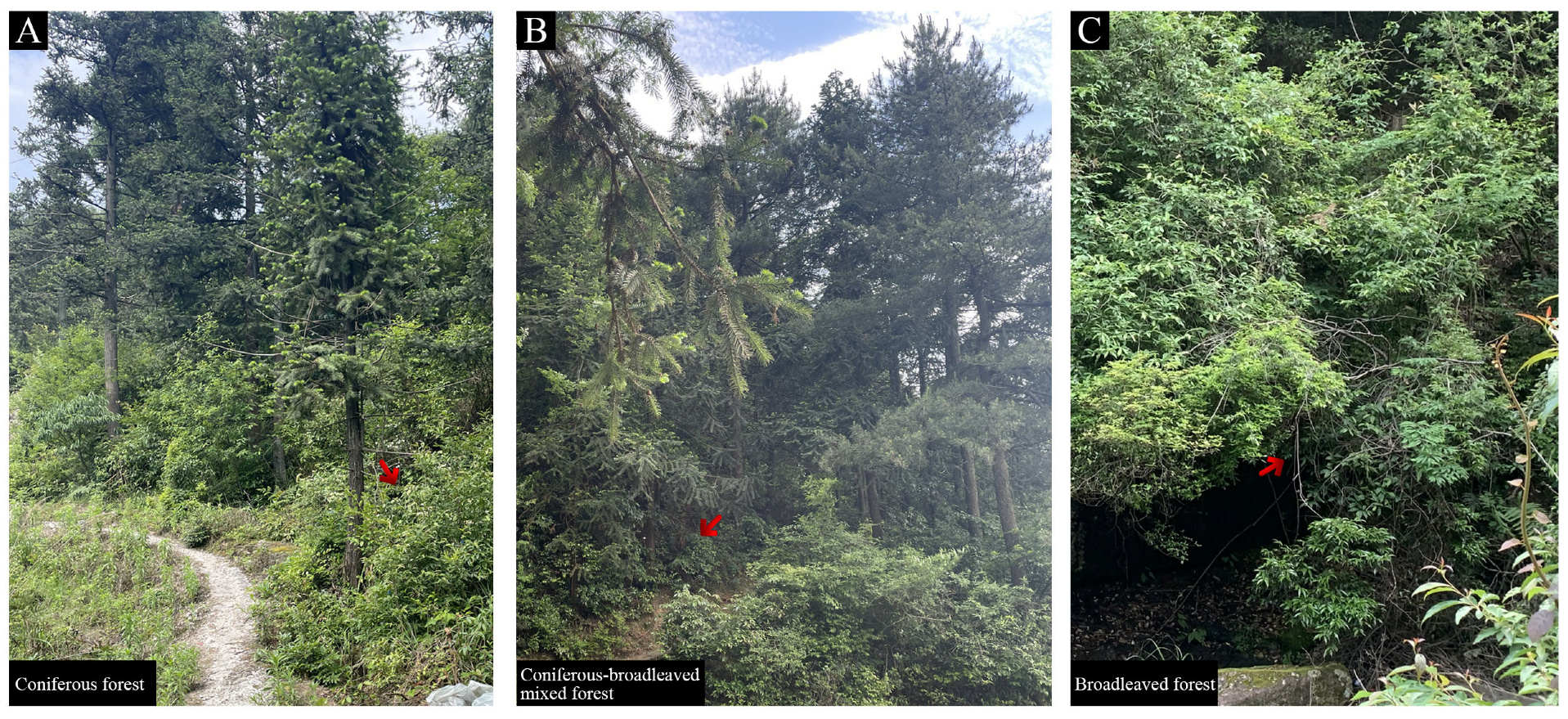

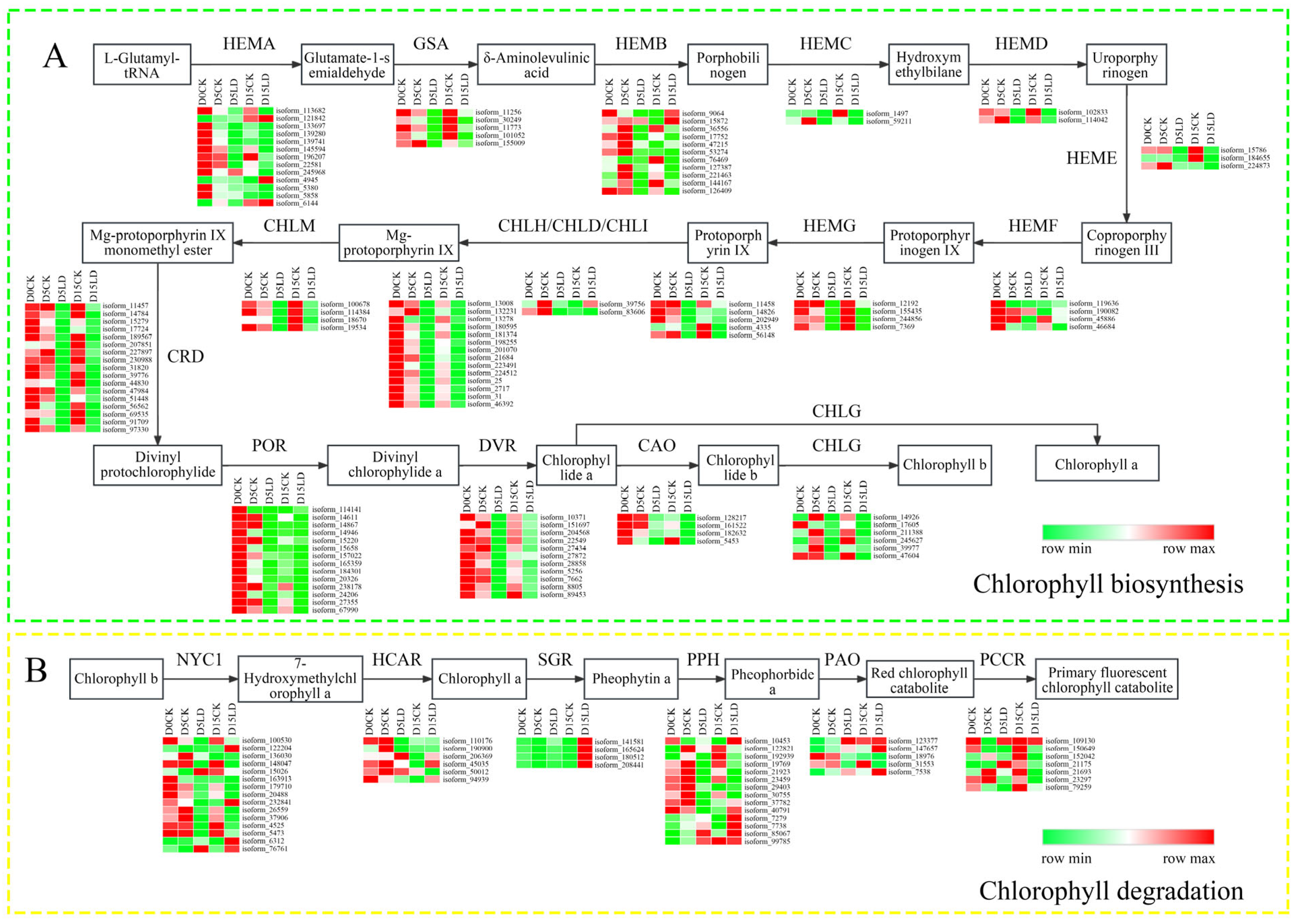

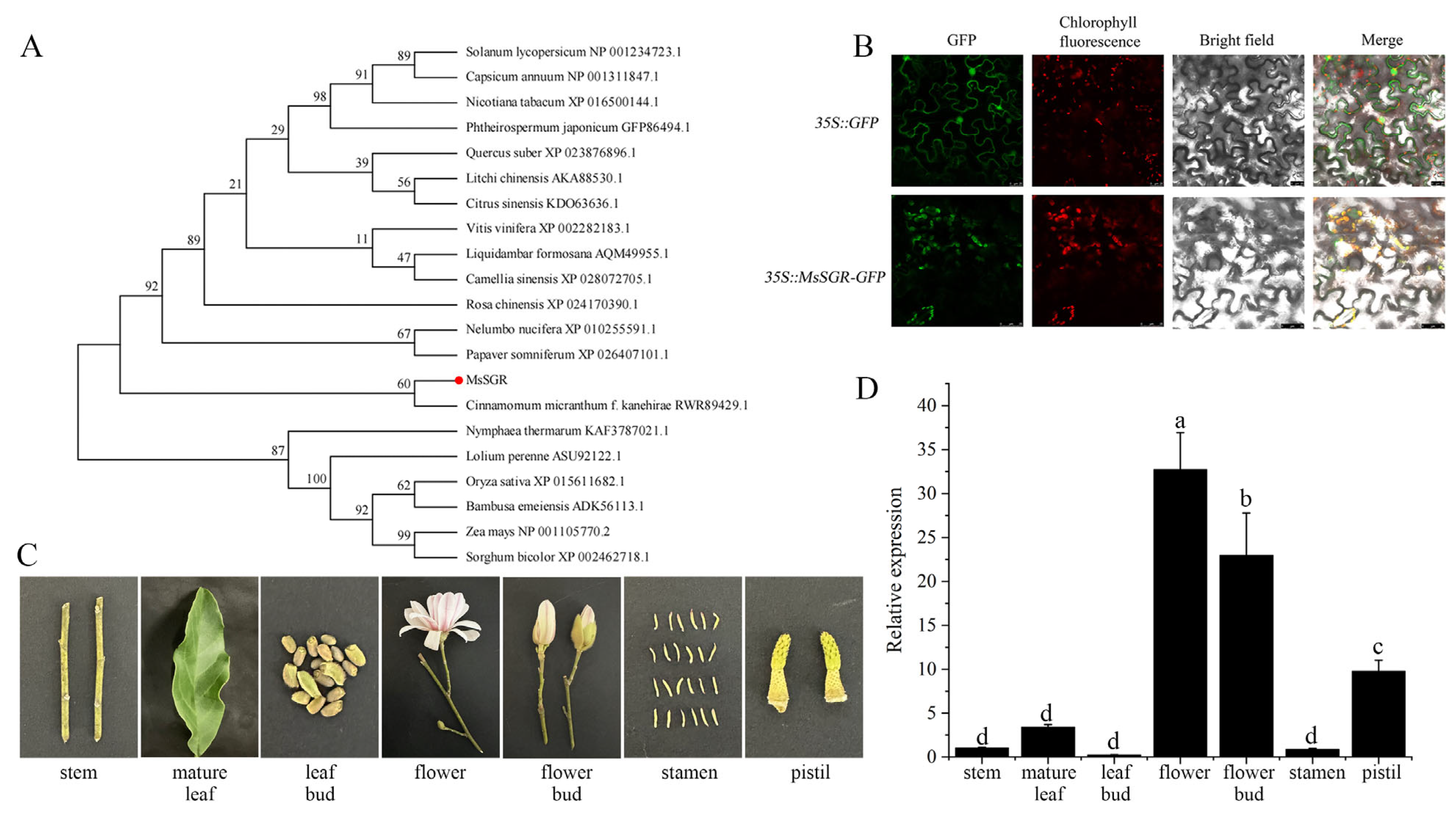
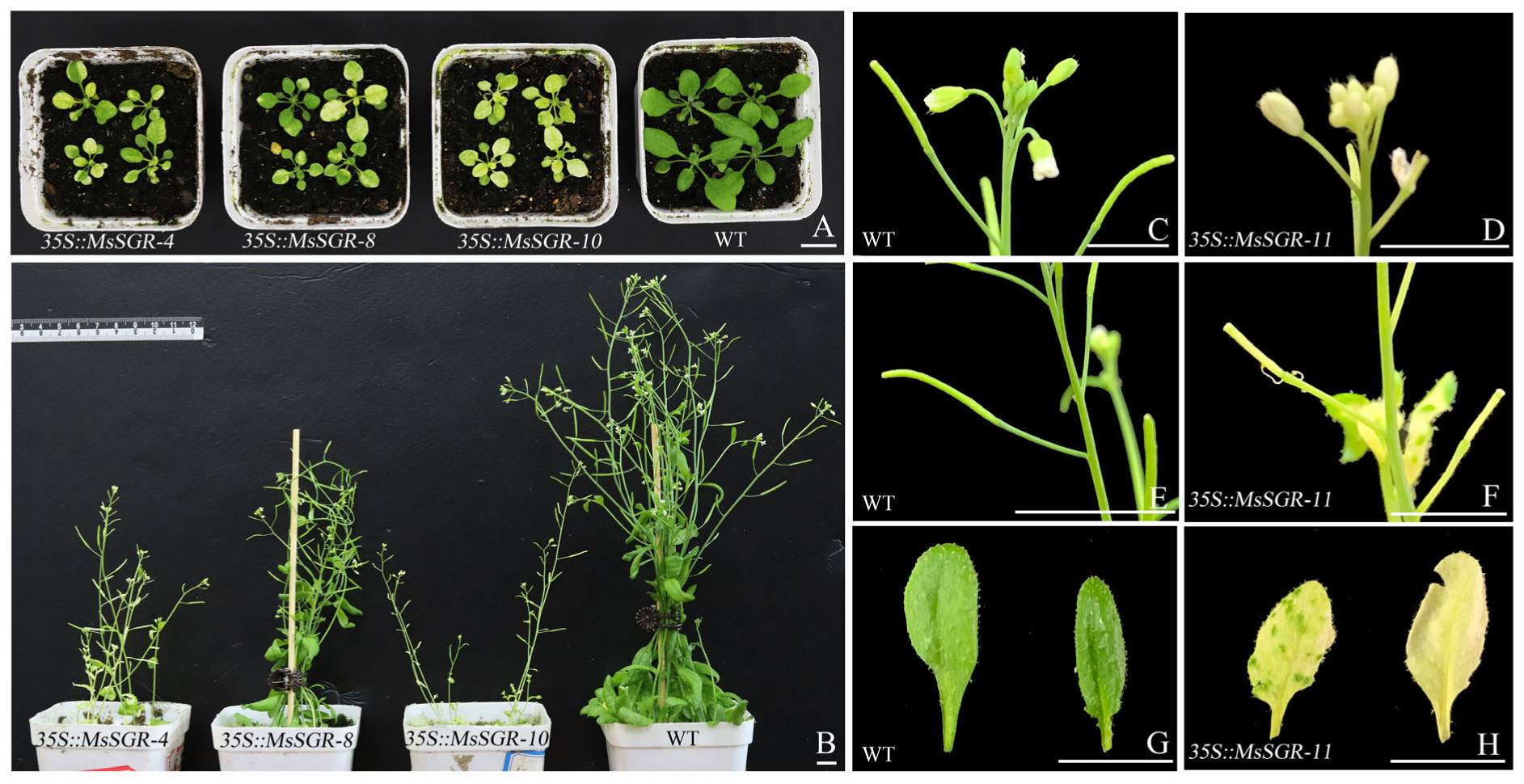
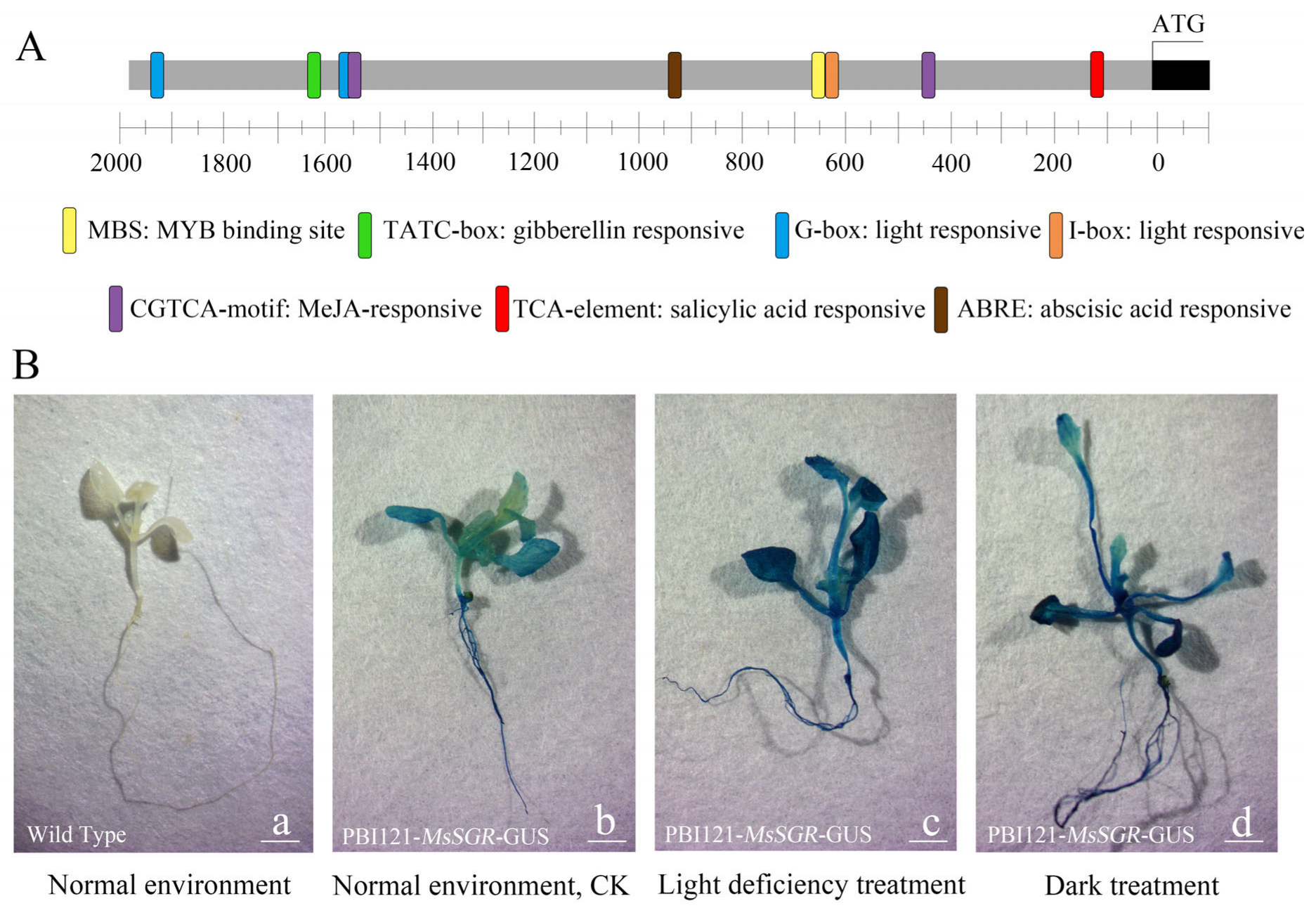
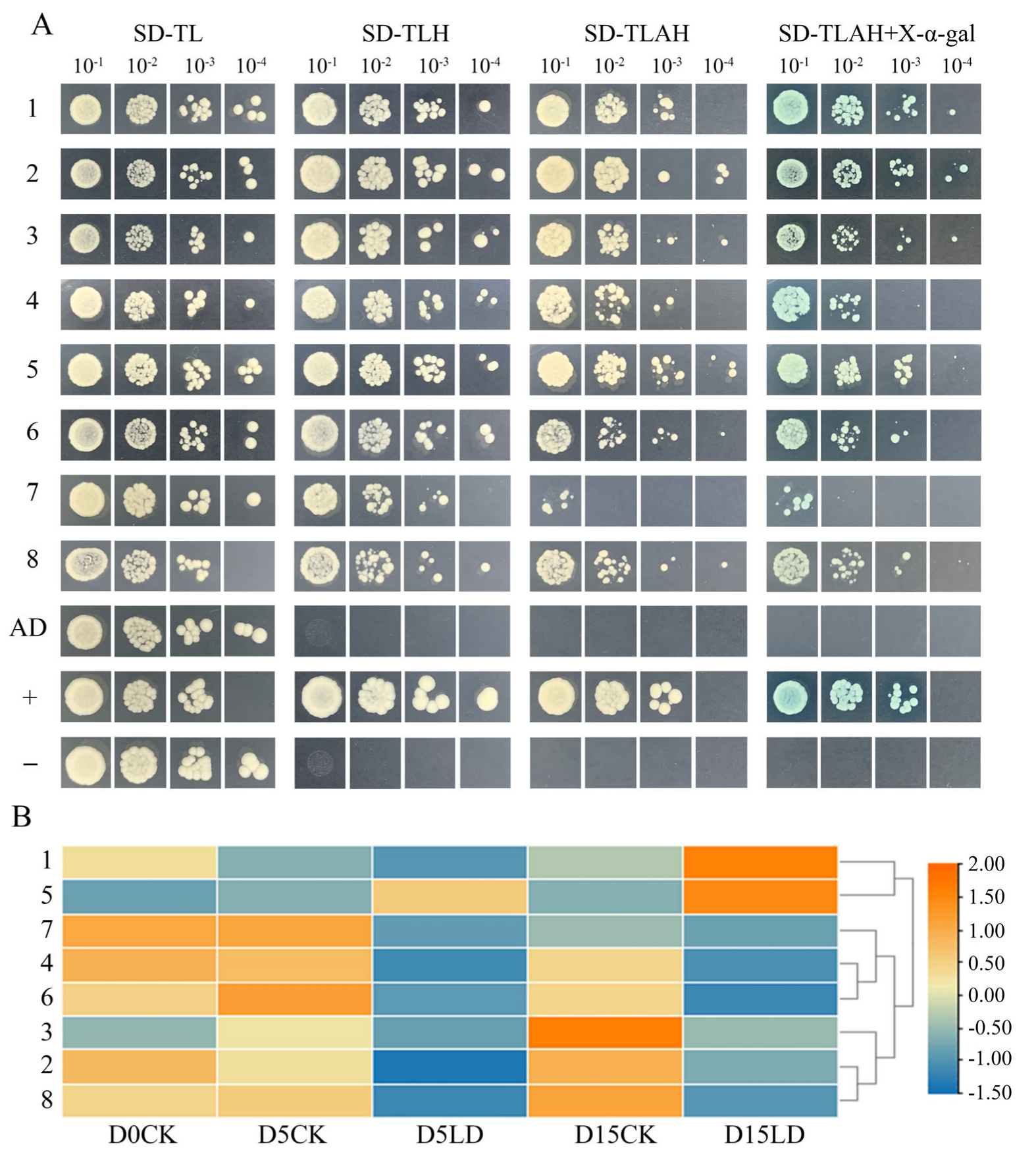
| Type | Side | Latitude | Longitude | Altitude | Aspect | Slope | Light Intensity/(Lx) | ||
|---|---|---|---|---|---|---|---|---|---|
| Coniferous forest | A | 28°18′58″ N | 119°49′12″ E | 990 | 318° Northwest | 16° | 60,000 | 56,000 | 53,000 |
| B | 28°18′58″ N | 119°46′12″ E | 1000 | 310° Northwest | 11° | 52,000 | 51,000 | 50,000 | |
| C | 28°12′59″ N | 119°46′11″ E | 980 | 20° North | 22° | 48,000 | 54,000 | 52,000 | |
| Coniferous-broadleaf mixed forest | A | 28°12′51″ N | 119°46′10″ E | 960 | 340° North | 42° | 501 | 360 | 350 |
| B | 28°12′51″ N | 119°46′10″ E | 960 | 358° North | 41° | 671 | 806 | 732 | |
| C | 28°12′51″ N | 119°46′11″ E | 970 | 344° North | 30° | 420 | 321 | 433 | |
| Broadleaf forest | A | 28°10′59″ N | 119°49′21″ E | 990 | 88° East | 25° | 207 | 238 | 212 |
| B | 28°10′58″ N | 119°49′21″ E | 980 | 74° East | 23° | 273 | 204 | 196 | |
| C | 28°10′58″ N | 119°49′21″ E | 990 | 87° East | 40° | 150 | 214 | 197 | |
| No. | GenBank No. | Homologous Protein | Clone Numbers |
|---|---|---|---|
| 1 | EHA8589896.1 | polyphenol oxidase, chloroplastic | 4 |
| 2 | XP_030942398.1 | peptidyl-prolyl cis-trans isomerase FKBP13, chloroplastic | 4 |
| 3 | XP_020695605.1 | ribulose bisphosphate carboxylase small chain, chloroplastic | 4 |
| 4 | XP_034688430.1 | PHOTOSYSTEM I ASSEMBLY 2, chloroplastic | 1 |
| 5 | RWR91980.1 | multiple organellar RNA editing factor 8, chloroplastic/mitochondrial-like | 1 |
| 6 | RWR94664.1 | ATP-dependent Clp protease proteolytic subunit-related protein 3, chloroplastic | 1 |
| 7 | RWR83419.1 | protein PTST, chloroplastic | 1 |
| 8 | XP_029123969.1 | uroporphyrinogen decarboxylase, chloroplastic | 1 |
Disclaimer/Publisher’s Note: The statements, opinions and data contained in all publications are solely those of the individual author(s) and contributor(s) and not of MDPI and/or the editor(s). MDPI and/or the editor(s) disclaim responsibility for any injury to people or property resulting from any ideas, methods, instructions or products referred to in the content. |
© 2023 by the authors. Licensee MDPI, Basel, Switzerland. This article is an open access article distributed under the terms and conditions of the Creative Commons Attribution (CC BY) license (https://creativecommons.org/licenses/by/4.0/).
Share and Cite
Ren, M.; Ma, J.; Lu, D.; Wu, C.; Zhu, S.; Chen, X.; Wu, Y.; Shen, Y. STAY-GREEN Accelerates Chlorophyll Degradation in Magnolia sinostellata under the Condition of Light Deficiency. Int. J. Mol. Sci. 2023, 24, 8510. https://doi.org/10.3390/ijms24108510
Ren M, Ma J, Lu D, Wu C, Zhu S, Chen X, Wu Y, Shen Y. STAY-GREEN Accelerates Chlorophyll Degradation in Magnolia sinostellata under the Condition of Light Deficiency. International Journal of Molecular Sciences. 2023; 24(10):8510. https://doi.org/10.3390/ijms24108510
Chicago/Turabian StyleRen, Mingjie, Jingjing Ma, Danying Lu, Chao Wu, Senyu Zhu, Xiaojun Chen, Yufeng Wu, and Yamei Shen. 2023. "STAY-GREEN Accelerates Chlorophyll Degradation in Magnolia sinostellata under the Condition of Light Deficiency" International Journal of Molecular Sciences 24, no. 10: 8510. https://doi.org/10.3390/ijms24108510
APA StyleRen, M., Ma, J., Lu, D., Wu, C., Zhu, S., Chen, X., Wu, Y., & Shen, Y. (2023). STAY-GREEN Accelerates Chlorophyll Degradation in Magnolia sinostellata under the Condition of Light Deficiency. International Journal of Molecular Sciences, 24(10), 8510. https://doi.org/10.3390/ijms24108510







